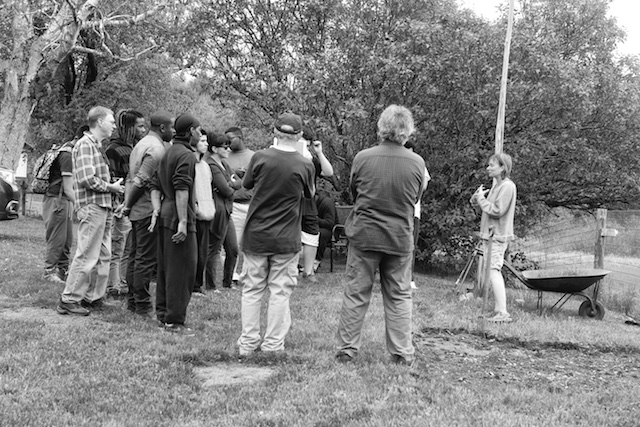
Maria spent almost all of the day digging out a new garden at the farm, she calls it the Three Sisters Garden. Above, she was explaining it to the boys from the St. John’s Residence (formerly orphanage) in New York City. A few week ago, I gave Maria a present, a beautiful book by Robin Wall Kimmerer called “Braiding Sweetgrass,” it is a tribute to plant life and a description of their inner lives and history.
In one chapter, Kimmerer tells a story so beautiful Maria can hardly stop crying when she reads it. It is about an ancient garden tradition, told to Kimmerer by a friend, Awaikta, a Cherokee writer, who pressed a small packet into her hand. It was a corn leaf, dry and folded into a pouch, tied with string. She was told not to open it until Spring.
In May, she wrote, “I untie the packet and there is the gift: three seeds. One is a golden triangle, a kernel of corn with a broadly dimpled top that narrows to a hard white tip. The glossy bean is speckled brown, curved and sleek, its inner belly marked with a white eye – the hilium.” And there was a pumpkin (squash) seed like an oval china dish, its edge crimped shut like a piecrust bulging with filling.
She held in her hand, writes Kimmerer, “the genius of indigenous agriculture, the Three Sisters.” Together, these plants, corn beans and squash, fed the Native Americans, fed the land, and still feed our imaginations, showing us how we might live.
When the colonists in Massachusetts first saw the Three Sisters, they scoffed at the natives, thinking they did not know how to make real gardens, which meant straight rows of single species, not a three-dimensional sprawl. But they ate the squash, beans and corn greedily and often.
The Three Sisters support one another, they offer each other shade, protection, nourishment.
Native people speak of this gardening style as the Three Sisters, there are many legends and stories about this kind of garden, but they all share the understanding of these plants as women, sisters. Some stories tell of a long winter when people were starving and suffering from the cold.
According to legend, three beautiful women came to their dwellings on a snowy night.
One was a tall woman dressed in yellow; the second wore green, and the third was robed in orange. The three came to shelter by the fire. Even thought food was scare, the three shared generously, and then the three sisters revealed their true identities – corn, beans, and squash – and gave themselves to the hungry people in a bundle of seeds so that they might never go hungry again.
So in this spirit we dug out the garden in the rear of the farmhouse next to the pasture fence, went out to buy the seeds we needed, dug out the stubborn roots and brought some bags of topsoil and decomposed manure. We will dedicate this garden to the earth, and plant it tomorrow to the spirit of generosity and community, of which we are all sorely in need.
The boys from St. John’s in New York City were mesmerized by the story of the garden, they peppered Maria with questions about it, they grasped it’s meaning and power right away.
We will plant some corn, beans and squash, protect it with some chicken wire, water it and love it every day, and see what happens. Maria is deeply committed to this project, and so am I. It is the most wonderful tradition, and it fits perfect into our lives here at the farm.
Now, we have a Three Sisters Garden.
